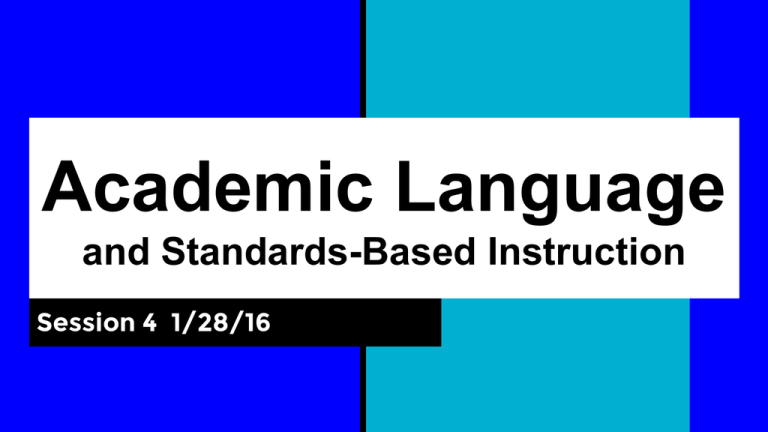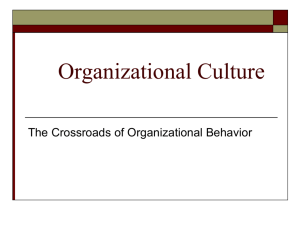Academic Language and Standards-Based Instruction
advertisement

Academic Language and Standards-Based Instruction Session 4 1/28/16 1. ALL educators need 15 PDPs in SEI for re-licensure. REMINDERS Licensure 2. DESE requires evidence of impact of PD on your practice, so keep all your writing/lesson plans with your PDP certificate. 3. SEI ENDORSEMENT is different from the SEI PDPs. (Only some educators require the SEI ENDORSEMENT.) REMINDERS Resources 1. All slides, handout and supporting materials are on the NAPS website (StaffProfessional Development – scroll down) Where have we been? Session 1: Introduction • Explain why there is an academic language gap linked to poverty • Identify Tier 1, 2, and 3 words in a text or discipline • Explain the connection between increasing productive student talks and improving student learning Session 2: Techniques for Building Academic Language • Develop and use effective word walls and anchor charts • Implement one or more best-practice techniques for teaching vocabulary • Design high-quality opportunities for student conversation (meaningful task, accountability, talk structure) Where have we been? (Continued) Session 3: Expanding Practice • Shared experiences from practice with academic language techniques • Five Core Skills for effective conversations • Planning time Where are we now? Agenda for today: 1. Exploring the Characteristics of Standards-based Teaching and Learning 2. Continuum of Practice: Self-Reflection 3. Video Activity: Using the Continuum 4. Plan a New Academic Language Lesson or Activity in Pairs or Trios 5. Return for Consultancy Feedback OBJECTIVES: By the end of this session, you will be able to... • Use an “academic language lens” to identify examples of standards-based teaching and learning • Design a higher-order academic language lesson or activity at the providing or sustaining level Characteristics of Standardsbased Teaching and Learning: Continuum of Practice The Continuum of Practice A common “reference point for looking at teaching and learning” ● Divided into 17 “Characteristics” of Standards-based Teaching and Learning ● Each Characteristic includes descriptors of the four levels of practice: No Evidence, Developing, Providing, Sustaining. Characteristics of Note (from the Continuum of Practice): #2. Learning objectives (not simply an agenda or an activity description) for the day’s lesson are evident. Applicable language objectives are evident for English language learners. #8. Instruction includes a range of techniques, such as direct instruction, facilitation, and modeling. #9. Lesson tasks and guiding questions lead students to engage in a process of application, analysis, synthesis, and evaluation. #12. When working in pairs or small groups, all students are inquiring, exploring, or problem solving collaboratively. #9. Lesson tasks and guiding questions lead students to engage in a process of application, analysis, synthesis, and evaluation. Review the Excerpt of Continuum #9 at your Table Discuss: • What are the descriptors of that level of practice? • What would that level of practice look like in your classroom or interactions with students? Ensure that each participant shares his or her own perspective. Activity: Jigsaw 1. Find people in the room who have the other three levels of practice. (Reminder: the four levels are No Evidence, Developing, Providing, Sustaining.) 2. Sit with that new group (with each person at the table representing one of the four different levels of practice). 3. Share your level of practice with the group, synthesizing the major ideas that you discussed at your previous table. Activity: 4 A’s Protocol At your table, use the full text of Continuum of Practice #9 as a reference to discuss these questions. • What Assumptions do the creators of this text hold? • What do you Agree with in the text? • Do you want to Argue with anything in the text? • What parts of the text do you want to Aspire to? • What does this mean for our work with students? How can this Continuum guide that work? Reflecting on Our Practice Reflecting on Previous Academic Language Lessons Reflect on a specific Academic Language lesson you have developed and implemented already (it could be one you prepared for PD homework or something else you tried out). Rate the implementation of the lesson using the #9 Continuum of Practice. • What went well? Give specific examples. • If you did the lesson again, what would you change? Why? • What descriptor of practice (from the Continuum examples) do you want to make sure to incorporate into the lesson you plan later today? Let’s Take a 10 Minute Break! Video Action: Identifying Examples of Practice Watch the video As you watch, look for examples of practice from the Continuum. Circle the descriptors that you see in the lesson. Video 1: https://www.youtube.com/watch?v=wZOy6w6UsMY Video 2: https://www.engageny.org/resource/grade-12-algebra-iitrigonometry-binomialprobability-scp9 Video 3: https://www.teachingchannel.org/videos/conver-stations-strategy Planning Time “Providing” and “Sustaining” Planning (30 Minutes) Working in content-specific groups of two or three, plan a lesson or activity that could be rated “providing” or “sustaining” on the #9 Continuum of Practice. In preparation for the feedback you will receive later today, also write a focus question that will guide the feedback… Consider what dilemma do you might face. What do you really want to get some perspective about? (i.e. “Do you think students will be engaged in this part of the lesson?” “How can I be sure student talk is productive in a lesson like this?” “What could be my next step to make this lesson better?”) Consultancy Protocol Consultancy Protocol • Presenter gives an overview of the dilemma and frames a question for the group to answer. • Group asks clarifying and probing questions. • Group discusses the question (presenter listens only at this time). • Presenter listens and takes notes, then shares something that resonated from the discussion. • Faciltator opens up time for discussion about the process or the conversations. Homework & Exit Ticket Homework for Next Session (March 3) • Bring your two best academic language lessons/activities and any relevant samples of student work or teacher-created materials to share as a mini “Academic Language Portfolio” at the final session. This mini-portfolio will be the product needed for the Professional Development Points. Note: These two lessons or activities could be ones that you have developed over the course of the four PD sessions so far! EXIT TICKET: Fill out your exit ticket and submit before you leave. Thank you!


